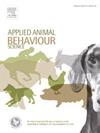Assessing the motivation of laying hens to outdoor space access
IF 2.2
2区 农林科学
Q1 AGRICULTURE, DAIRY & ANIMAL SCIENCE
引用次数: 0
Abstract
The present study aimed at evaluating the motivation of laying hens to access outdoor space and their behavior under indoor and outdoor conditions. A total of 54 laying hens (White Leghorns) at 38 weeks of age were housed in two experimental groups: indoors, 3 replicates of 9 hens each (10 hens/m2), and outdoors, 3 replicates of 9 hens each (10 m2/hen). The behavioral evaluation was performed using a video recording system, and the videos were analyzed using a scan sampling method. The motivation test was carried out in one of the replicates (9 hens in total) with outdoor access. To access the feed (used as gold standard) and to the outdoor area, hens had to push a transparent one-way door with increasing weight (100 g every two days). The test was interrupted when each hen did not pass through the door for two consecutive days. The motivational drive to access the two settings (i.e., feed and outdoor space) was quantified by constructing a behavioral demand function and calculating various indices based on economic theories. The number of visits per hen decreased when the door weight increased in both groups (P < 0.001). Nevertheless, while no hen reached the feed when the door weighed 650 g, hens opened the door up to a weight of 750 g to access the outside space. Reservation price (the maximum weight each hen pushed to access a specific resource) and total travel consumer surplus (the cumulative effort exerted by each hen during the test to reach a specific resource) averaged 445 g and 6.881 kg, respectively, without differences between resources. Moreover, the budget allocation was similar for feed and outdoor space. However, the demand for outdoor access resulted in a more inelastic trend than that for feed (P = 0.002), and the expenditure rate (the daily effort exerted by each hen during the test to reach a specific resource) was significantly higher for outdoor space as compared to feed (P < 0.001). In the group with access to an outdoor area, finally, the proportion of hens walking and self-grooming increased, while the proportion of hens resting decreased compared to the group kept indoors (P < 0.001). In conclusion, the present study demonstrates that laying hens are highly motivated to access outdoor space where they can find grass and other valuable resources and perform species-specific behaviors.
蛋鸡进入户外空间的动机评估
本研究旨在评价蛋鸡进入室外空间的动机及其在室内和室外条件下的行为。试验选用38周龄的白来角蛋鸡54只,分为2个试验组:室内3个重复,每组9只(10只/m2),室外3个重复,每组9只(10 m2/母鸡)。使用视频记录系统进行行为评估,并使用扫描采样方法对视频进行分析。动机试验在室外通道的1个重复(共9只鸡)进行。为了进入饲料(这是黄金标准)和室外区域,母鸡必须推一个增加重量的透明单向门(每两天推100 g)。当每只母鸡连续两天不进门时,测试被中断。基于经济学理论,构建行为需求函数并计算各项指标,量化了进入饲料和室外空间两种环境的动机驱动。每只母鸡的到访次数随着门重的增加而减少(P <; 0.001)。然而,当门重650 g时,没有母鸡够到饲料,母鸡打开门到750 g进入外面的空间。保留价格(每只母鸡为获得特定资源所推的最大重量)和总旅行消费者剩余(每只母鸡在测试期间为达到特定资源所施加的累积努力)的平均分别为445 g和6.881 kg,资源之间没有差异。此外,饲料和室外空间的预算分配相似。然而,室外空间的需求比饲料的需求更具非弹性趋势(P = 0.002),室外空间的消耗率(试验期间每只母鸡为达到特定资源所付出的每日努力)显著高于饲料(P <; 0.001)。最后,与室内饲养组相比,在可进入室外区域的组中,母鸡走路和自我梳理的比例增加,而母鸡休息的比例减少(P <; 0.001)。综上所述,本研究表明,蛋鸡有很强的动力进入户外空间,在那里它们可以找到草和其他有价值的资源,并进行特定物种的行为。
本文章由计算机程序翻译,如有差异,请以英文原文为准。
求助全文
约1分钟内获得全文
求助全文
来源期刊

Applied Animal Behaviour Science
农林科学-行为科学
CiteScore
4.40
自引率
21.70%
发文量
191
审稿时长
18.1 weeks
期刊介绍:
This journal publishes relevant information on the behaviour of domesticated and utilized animals.
Topics covered include:
-Behaviour of farm, zoo and laboratory animals in relation to animal management and welfare
-Behaviour of companion animals in relation to behavioural problems, for example, in relation to the training of dogs for different purposes, in relation to behavioural problems
-Studies of the behaviour of wild animals when these studies are relevant from an applied perspective, for example in relation to wildlife management, pest management or nature conservation
-Methodological studies within relevant fields
The principal subjects are farm, companion and laboratory animals, including, of course, poultry. The journal also deals with the following animal subjects:
-Those involved in any farming system, e.g. deer, rabbits and fur-bearing animals
-Those in ANY form of confinement, e.g. zoos, safari parks and other forms of display
-Feral animals, and any animal species which impinge on farming operations, e.g. as causes of loss or damage
-Species used for hunting, recreation etc. may also be considered as acceptable subjects in some instances
-Laboratory animals, if the material relates to their behavioural requirements
 求助内容:
求助内容: 应助结果提醒方式:
应助结果提醒方式:


